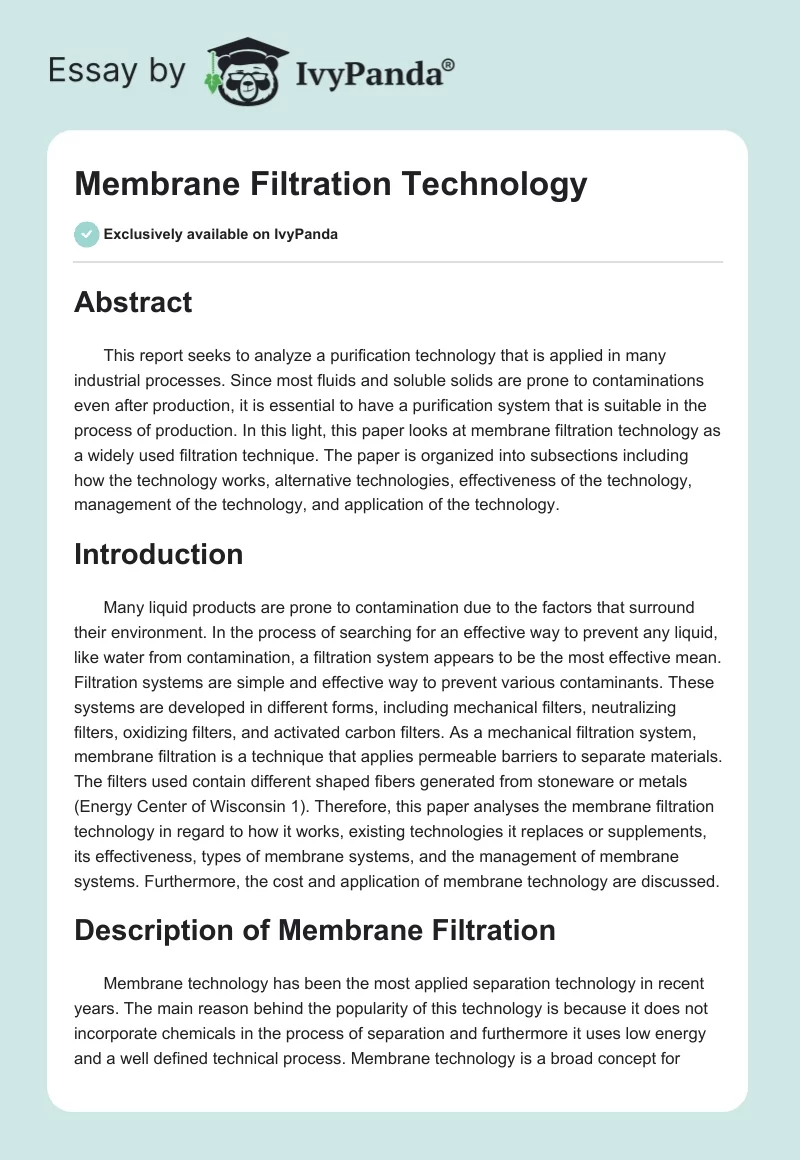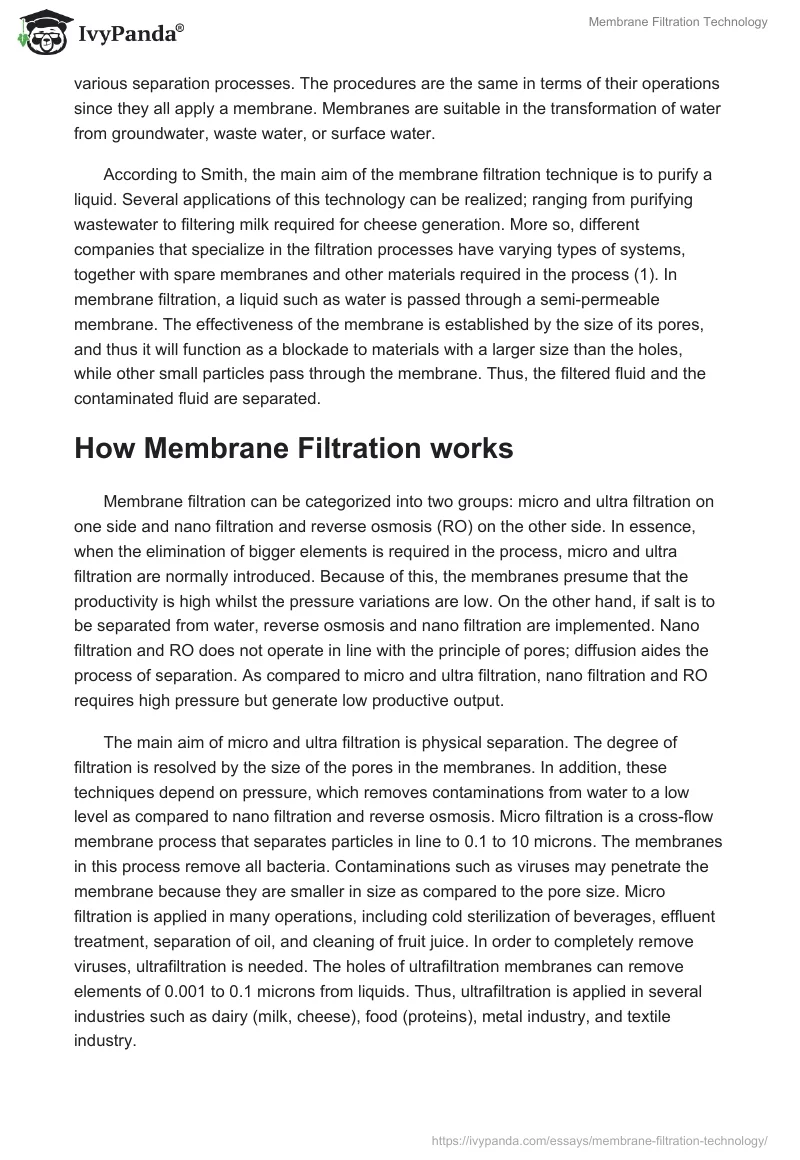Abstract
This report seeks to analyze a purification technology that is applied in many industrial processes. Since most fluids and soluble solids are prone to contaminations even after production, it is essential to have a purification system that is suitable in the process of production. In this light, this paper looks at membrane filtration technology as a widely used filtration technique. The paper is organized into subsections including how the technology works, alternative technologies, effectiveness of the technology, management of the technology, and application of the technology.
Introduction
Many liquid products are prone to contamination due to the factors that surround their environment. In the process of searching for an effective way to prevent any liquid, like water from contamination, a filtration system appears to be the most effective mean. Filtration systems are simple and effective way to prevent various contaminants. These systems are developed in different forms, including mechanical filters, neutralizing filters, oxidizing filters, and activated carbon filters. As a mechanical filtration system, membrane filtration is a technique that applies permeable barriers to separate materials. The filters used contain different shaped fibers generated from stoneware or metals (Energy Center of Wisconsin 1). Therefore, this paper analyses the membrane filtration technology in regard to how it works, existing technologies it replaces or supplements, its effectiveness, types of membrane systems, and the management of membrane systems. Furthermore, the cost and application of membrane technology are discussed.
Description of Membrane Filtration
Membrane technology has been the most applied separation technology in recent years. The main reason behind the popularity of this technology is because it does not incorporate chemicals in the process of separation and furthermore it uses low energy and a well defined technical process. Membrane technology is a broad concept for various separation processes. The procedures are the same in terms of their operations since they all apply a membrane. Membranes are suitable in the transformation of water from groundwater, waste water, or surface water.
According to Smith, the main aim of the membrane filtration technique is to purify a liquid. Several applications of this technology can be realized; ranging from purifying wastewater to filtering milk required for cheese generation. More so, different companies that specialize in the filtration processes have varying types of systems, together with spare membranes and other materials required in the process (1). In membrane filtration, a liquid such as water is passed through a semi-permeable membrane. The effectiveness of the membrane is established by the size of its pores, and thus it will function as a blockade to materials with a larger size than the holes, while other small particles pass through the membrane. Thus, the filtered fluid and the contaminated fluid are separated.
How Membrane Filtration works
Membrane filtration can be categorized into two groups: micro and ultra filtration on one side and nano filtration and reverse osmosis (RO) on the other side. In essence, when the elimination of bigger elements is required in the process, micro and ultra filtration are normally introduced. Because of this, the membranes presume that the productivity is high whilst the pressure variations are low. On the other hand, if salt is to be separated from water, reverse osmosis and nano filtration are implemented. Nano filtration and RO does not operate in line with the principle of pores; diffusion aides the process of separation. As compared to micro and ultra filtration, nano filtration and RO requires high pressure but generate low productive output.
The main aim of micro and ultra filtration is physical separation. The degree of filtration is resolved by the size of the pores in the membranes. In addition, these techniques depend on pressure, which removes contaminations from water to a low level as compared to nano filtration and reverse osmosis. Micro filtration is a cross-flow membrane process that separates particles in line to 0.1 to 10 microns. The membranes in this process remove all bacteria. Contaminations such as viruses may penetrate the membrane because they are smaller in size as compared to the pore size. Micro filtration is applied in many operations, including cold sterilization of beverages, effluent treatment, separation of oil, and cleaning of fruit juice. In order to completely remove viruses, ultrafiltration is needed. The holes of ultrafiltration membranes can remove elements of 0.001 to 0.1 microns from liquids. Thus, ultrafiltration is applied in several industries such as dairy (milk, cheese), food (proteins), metal industry, and textile industry.
The main aim of nanofiltration and RO is to produce univalent and bivalent ions. Nanofiltration is effective when RO and ultrafiltration fail to meet their objectives. It uses pressure and bases its separation on molecule size. Nanofiltration is used in demineralization, desalination, and color removal. On the other hand, RO relies on the concept of balancing. Two liquids with different rates of dissolved solids are mixed to the same concentration. When membrane filtration is activated, a fluid having a lesser concentration moves through the membrane to the fluids having higher concentration of dissolved solids. By exerting pressure in the fluid column, a reversed effect is realized and thus fluids return to the other side, while solids dissolved stay in the column. Using this method, salt content may be separated from water. Therefore, reverse osmosis is applied in water softening, process water production, and ultrapure water production (Lenntech 1).
Consequently, membrane filtration can be implemented as an alternative for technologies such as evaporative heating, flocculation, adsorption, extraction and distillation. Evaporative heating is normally used to concentrate elements and generate raw materials. It is an energy intensive technology since a lot of heat is required in the evaporation process. Flocculation is a method that filters destabilized particles into floc. Likewise, in adsorption, a solid is used to remove a soluble component from water; active carbon acts as the solid. Other technologies like extraction and distillation are prone to allowing impurities into the generated fluids. Thus, membrane distillation can be used as an alternative or a supplement to these technologies.
Effectiveness of Membrane Filtration
Every system’s functionality is based on its performance in relation to productivity. One of the quality measures of a system is efficiency. In membrane technology, two factors determine the effectiveness of the processes; productivity and selectivity. Productivity is estimated as a flux parameter, while selectivity is determined through retention or separation factor. These determinants are membrane-depended. Thus, to achieve the objective of filtration, membrane technology provides the following benefits: (a) it can occur within low temperatures. This is essential since it insures the purification of heat sensitive elements, hence useful in food production; (b) it requires low energy in terms of cost. The overall energy required is less, as compared to the other techniques discussed in the previous section; and (c) it can be expanded easily (Lenntech).
Membrane Systems and Cost
The selection of a membrane system depends on factors such as cost, risks of setting up membranes, and cleaning opportunities. Large surfaces applied as one flat plate for membrane can result to high costs, thus membrane systems are set up densely in consideration of surface volume. As compared to other techniques such as evaporation, the capital costs for membrane filtration are high, but it can efficiently lower the operation costs by 65% or even more and the use of energy by 95% (Energy Center of Wisconsin 1). Therefore, these systems can be termed as tubular and plate and frame. The tubular structures are separated in the tubular, void strand, and capillary casings. While the plate and frame membranes are separated in spiral casings and pillow-shaped casings (Lenntech). However, the effect of membrane fouling is uncontrollable during the filtration process. The rate of un-cleanliness is determined by factors like source water quality, membrane material and type, and the design of the system. Smith suggests that elements, scaling and biofouling are the major inconveniences in the system. These problems affect the functionality of the membranes and it may require the effort of designers to ensure that any foul is dealt with. In this regard, the various techniques that are widely used in ensuring that membranes are clean include forward and backward flushing, and chemical cleaning.
Membrane Systems Management
Two approaches used in running membrane systems are dead-end and cross-flow separation. This is in view to realizing the highest feasible production within a long period, with tolerable pollution levels. When the dead-end filtration process is applied, all the source water entering the membrane shell is exerted through the membrane. Other particles will be left behind as water permeates. Again, it depends on the size of the pores. In addition, greater resistance of passage will be on the water. When the pressure is persistent, the flux will reduce, leading to the need of cleaning the membrane. The dead-end approach is essential since energy loss is less as compared to cross-flow management. It is because of the fact that all energy is exerted in the water crossing the membrane. More so, dead-end filtration is a discrete process, in that, when cleaning is necessary, a component is temporarily stopped. This lessens productivity.
In the case of cross-flow filtration, supply water is recycled. During the process of retransmission the water streams in equivalence to the membrane. Small part of the supply water is used in the filtration process, other part leaves the system. More so, this process experiences a high cost of energy. The whole flow of water requires pressure to enhance functionality, and the speed is high so as to prevent the breadth of the block. In essence, the cross-flow approach can lead to stable fluxes. However, cleanliness is required routinely, and thus this method is implemented for nano filtration, reverse osmosis, micro and ultra filtration in regard to the size of the membrane’s holes.
Applications of Membrane Technology
Membrane filtration systems are applied in many fields. The most common applications of this technology are food and beverage applications and industrial applications. Membrane filtration systems are being used in processing a variety of products. In processing food and beverages, the technology uses systems like micro filtration, ultra filtration, and reverse osmosis with either stainless steel or spiral-wound. Beverages and food that are processed using this technology include juices: vegetable juices (e.g. carrot, celery, garlic), fruit juices (e.g. strawberry, orange); and potato starch recovery. The starch and sweetener industry and sugar industry have also incorporated membrane technology to increase productivity. In industrial applications, membrane filtration has been applied in the production of ethanol, de-salting, clean-up of wash water streams, pigment production, metal production among others (GEA Filtration).
Conclusion
Any purification technique aims at achieving a more productive output. The systems used to purify fluids depend on the type of materials used and the process followed. Membrane filtration aims at separating contaminations from soluble solids and liquids so as to generate a more reliable product. In this report, the operations of a membrane technology have been discussed including the types of membrane systems, the effectiveness of the technology, managing the system, and the application of the technology. In essence, membrane technology is cost efficient technique in regard to energy as compared to other techniques such as evaporation and filtration. Consequently, reverse osmosis, micro, nano, and ultra filtration are the various methods used in this purification process. On the other hand, membrane purification processes might be controlled through a cross stream method or dead-end stream. Therefore, membrane technology is commonly used in food and beverage production and industry applications.
References
Energy Center of Wisconsin. Membrane Filtration. 2000. Web.
GEA Filtration. Cross-flow membrane filtration systems and replacement membranes. 2009. Web.
Lenntech. Membrane Technology. 2009. Web.
Smith, S.E. What is Membrane Filtration? 2010. Web.


